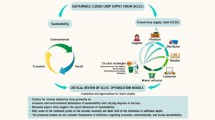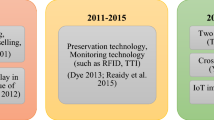Abstract
This study presents an uncertain mathematical model for maximizing profit of the defective goods supply chain during uncertain situations by using selection of appropriate suppliers, just-in-time (JIT) logistic philosophy and minimizing total costs including costs of production, shipping, holding, defective goods, scrap goods, shortage in retailers. The selections of suppliers are based on three criteria, namely, quality, JIT delivery, and level of responsibility, which have important roles in the production of perfect goods by manufacturers. In each criterion, two kinds of indicators are considered by manufacturers. The first indicator is the importance of the weighted factor of each criterion for each manufacturer, and the second is weighted factor of each supplier with respect to each criterion. The proposed mathematical model with uncertain parameters and the probability of occurring in various scenarios is investigated. The model is studied in ten scenarios and the average amount is calculated. The mentioned mathematical model is solved by the averages of the parameters using CPLEX.12 solver and Expert Choice software. The findings of the model are maximum profit, amounts of economic production quantity, defective goods, scrap goods, and amounts of products that should be exchanged among the nodes of the supply chain. To achieve maximum benefit, the model can select the appropriate suppliers. The results obtained demonstrate the validity and efficiency of the proposed uncertain mathematical model.







Similar content being viewed by others
References
Aissaoui, N., Haouari, M., & Hassini, E. (2007). Supplier selection and order lot sizing modeling: A review. Computers & Operations Research, 34, 3516–3540.
Aliabadi, E., Danial, A. K., & Pourghannad, B. (2013). A two-level GA to solve an integrated multi-item supplier selection model. Applied Mathematics and Computation, 219, 7600–15.
Amaro, C. S., & Barbosa-Póvoa, P. F. D. (2009). The effect of uncertainty on the optimal closed-loop supply chain planning under different partnerships structure. Computers & Chemical Engineering, 33, 2144–2158.
Amid, A., Ghodsypour, S. H., & Brien, C. O. (2006). Fuzzy multiobjective linear model for supplier selection in a supply chain. International Journal of Production Economics, 104, 394–407.
Amid, A., Ghodsypour, S. H., & O’Brien, C. (2011). A weighted max–min model for fuzzy multi-objective supplier selection in a supply chain. International Journal of Production Economics, 131, 139–145.
Ávila, P., Mota, A., & Pires, A. (2012). Supplier ’ s selection model based on an empirical study. Procedia Technology, 5, 625–34.
Basnet, C., & Leung, J. M. Y. (2005). Inventory lot-sizing with supplier selection. Computers & Operations Research, 32, 1–14.
Berman, O., & Wang, Q. (2006). Inbound logistic planning: Minimizing transportation and inventory cost. Transportation Science, 40, 287–299.
Bharadwaj, N. (2004). Investigating the decision criteria used in electronic components procurement. Industrial Marketing Management, 33, 317–23.
Biswajit, S., & Majumder, A. (2013). Integrated vendor–buyer supply chain model with vendor’s setup cost reduction. Applied Mathematics and Computation, 224, 362–371.
Carrera, D. A., & Mayorga, R. V. (2008). Supply chain management: A modular fuzzy inference system approach in supplier selection for new product development. Journal of Intelligent Manufacturing, 19(1), 1–12.
Chong, L., & Liu, S. (2012). A stochastic network model for ordering analysis in multi-stage supply chain systems. Simulation Modelling Practice and Theory, 22, 92–108.
Chen, C., Lin, C., & Huang, S. (2006). A fuzzy approach for supplier evaluation and selection in supply chain management. International Journal of Production Economics, 102, 289–301.
Chou, S. (2008). A decision support system for supplier selection based on a strategy-aligned fuzzy SMART approach. Expert Systems with Applications, 34, 2241–2253.
Chu, W. C., Chen, J.-N., Lee, C.-Y., & Yang, H. (2001) Implementing an agent system using N-tier pattern-based framework. In: Paper presented at the compsac.
Chu, X., Tso, S., Zhang, W., & Li, Q. (2002). Partnership synthesis for virtual enterprises. The International Journal of Advanced Manufacturing Technology, 19(5), 384–391.
Gangaraju, V., Babu, R., & Gushikin, O. (2011). Supply chain focus dependent supplier selection problem. International Journal of Production Economics, 129, 204–216.
Ghodsypour, S. H., & Brien, C. O. (2001). The total cost of logistics in supplier selection, under conditions of multiple sourcing, multiple criteria and capacity constraint. International Journal of Production Economics, 73, 15–27.
Gjerdrum, J., Shah, N., & Papageorgiou, L. G. (2001). A combined optimization and agent-based approach to supply chain modelling and performance assessment. Production Planning & Control, 12(1), 81–88.
Golmohammadi, D., & Mellat-Parast, M. (2012). Developing a grey-based decision-making model for supplier selection. International Journal of Production Economics, 137, 191–200.
Guo, R., & Tang, Q. (2008). An optimized supply chain planning model for manufacture company based on JIT. International Journal of Business and Management, 3, 129–133.
Hang, G., Chan, S., Sik, D., & Min, H. (2005). An effective supplier selection method for constructing a competitive supply-relationship. Expert Systems with Applications, 28, 629–39.
Jamal, M. M., Sarker, B. R., & Mondal, S. (2004). Optimal manufacturing batch size with rework process at a single-stage production system. Computers & Industrial Engineering, 47, 77–89.
Jiao, J. R., Simpson, T. W., & Siddique, Z. (2007). Product family design and platform-based product development: a state-of-the-art review. Journal of intelligent Manufacturing, 18(1), 5–29.
Kawtummachai, R., & Van Hop, N. (2005). Order allocation in a multiple-supplier environment. International Journal of Production Economics, 94, 231–238.
Liao, C., & Kao, H. (2011). Expert systems with applications an integrated fuzzy TOPSIS and MCGP approach to supplier selection in supply chain management. Expert Systems with Applications, 38, 10803–108011.
Liao, Z., & Rittscher, J. (2007). A multi-objective supplier selection model under stochastic demand conditions. International Journal of Production Economics, 105, 150–159.
Lin, S.-W., Wou, Y.-W., & Julian, P. (2011). Note on minimax distribution free procedure for integrated inventory model with defective goods and stochastic lead time demand. Applied Mathematical Modelling, 35, 2087–2093.
Liu, F. F., & Hai, H. L. (2005). The voting analytic hierarchy process method for selecting supplier. International Journal of Production Economics, 97, 308–317.
Majid, R., Bashiri, M., & Tavakkoli-Moghaddam, R. (2013). A new multi-objective stochastic model for a forward/reverse logistic network design with responsiveness and quality level. Applied Mathematical Modelling, 37, 328–344.
Pal, B., Sana, S. S., & Chaudhuri, K. (2012). Three-layer supply chain—A production-inventory model for reworkable items. Applied Mathematics and Computation, 219, 530–543.
Saen, R. F. (2006a). A decision model for selecting technology suppliers in the presence of nondiscretionary factors. Applied Mathematics and Computation, 181, 1609–1615.
Saen, R. F. (2006b). An algorithm for ranking technology suppliers in the presence of nondiscretionary factors. Applied Mathematics and Computation, 181, 1616–1623.
Saen, R. F. (2007). A new mathematical approach for suppliers selection: Accounting for non-homogeneity is important. Applied Mathematics and Computation, 185, 84–95.
Song, H.-M., Yang, H., & Bensoussan, A. (2013). Optimizing production and inventory decisions in a supply chain with lot size, production rate and lead time interactions. Applied Mathematics and Computation, 224, 150–165.
Thiruchelvam, S., & Tookey, J. E. (2011). Evolving trends of supplier selection criteria and methods. Journal, International Engineering, Mechanical, 4, 437–454.
Tsiakis, P., Shah, N., & Pantelides, C. C. (2001). Design of multi-echelon supply chain networks under demand uncertainty. Industrial & Engineering Chemistry Research, 40(16), 3585–3604.
Wahab, M. I. M., & Jaber, M. Y. (2010). Economic order quantity model for items with imperfect quality, different holding costs, and learning effects: A note. Computers & Industrial Engineering, 58, 186–190.
Wang, J., Ip, W., Muddada, R. R., Huang, J., & Zhang, W. (2013). On Petri net implementation of proactive resilient holistic supply chain networks. The International Journal of Advanced Manufacturing Technology, 69(1–4), 427–437.
Wang, J., Muddada, R. R., Wang, H., Ding, J., Lin, Y., Liu, C., & Zhang, W. (2014). Toward a resilient holistic supply chain network system: Concept, review and future direction. IEEE Systems Journal, PP(99), 1–12.
Weber, C. A., Current, J. R., & Desai, A. (1998). Non-cooperative negotiation strategies for vendor selection. European Journal of Operational Research, 108, 208–223.
Wee, H. M., Lee, M. C., Yang, P. C., & Chung, R. L. (2013). Bi-level vendor–buyer strategies for a time-varying product price. Applied Mathematics and Computation, 219, 9670–9680.
Xiao, Z., Chen, W., & Li, L. (2012). An integrated FCM and fuzzy soft set for supplier selection problem based on risk evaluation. Applied Mathematical Modelling, 36, 1444–1454.
Zeballos, L. J., Isabel Gomes, M., Barbosa-Povoa, A. P., & Novais, A. Q. (2012). Addressing the uncertain quality and quantity of returns in closed-loop supply chains. Computers & Chemical Engineering, 47, 237–247.
Zhang, A. X. (1997). Demand fulfillment rates in an assembleto-order system with multiple products and dependent demands. Production and Operations Management, 6(3), 309–324.
Zhang, X., Lu, Q., & Wu, T. (2011). Petri-net based applications for supply chain management: an overview. International Journal of Production Research, 49(13), 3939–3961.
Author information
Authors and Affiliations
Corresponding author
Rights and permissions
About this article
Cite this article
Ghasimi, S.A., Ramli, R., Saibani, N. et al. An uncertain mathematical model to maximize profit of the defective goods supply chain by selecting appropriate suppliers. J Intell Manuf 29, 1219–1234 (2018). https://doi.org/10.1007/s10845-015-1172-z
Received:
Accepted:
Published:
Issue Date:
DOI: https://doi.org/10.1007/s10845-015-1172-z




